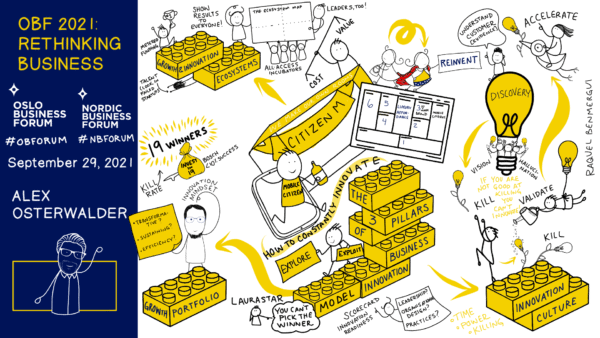4Oct2021
Dr. Alex Osterwalder is an innovation expert, leading author, and entrepreneur whose work has changed the way companies do business. Ranked fourth on the Thinkers50 list of the most influential management thinkers worldwide, he is known for turning complex concepts into digestible visual models. He invented the Business Model Canvas, Value Proposition Canvas, and Business Portfolio Map—all practical tools trusted by leading global companies. In his interactive session at the Oslo Business Forum, Alex offered leaders exercises to assess and strengthen the three pillars of business model innovation: their growth portfolios, their growth and innovation initiatives, and their innovation culture.
The Types of Innovation
In today’s landscape, many leaders recognize that inspiration to innovate is easy to come by—but actually doing it is hard. In Alex’s opinion, “Commitment is the only thing missing.” He opened his session with an overview of the three types of innovation organizations may commit to:
- Efficient Innovation to get better at what you’re already doing.
- Sustainable Innovation to bring your existing business model more current.
- Transformative Innovation to strengthen your business model for the future.
Alex used Amazon as an example of an organization skilled in all three types of innovation: Their investment in robots to manage E-commerce has made them more efficient. Their investment in the Kindle made their business more sustainable. Their investment in cloud computing is transforming their business for the future.
Primed with this understanding of the types of innovation they might invest in, leaders in the room were ready to evaluate their growth portfolios, assess their growth and innovation initiatives, and understand their innovation cultures.
Evaluating Your Growth Portfolio
The first pillar of business model innovation is your growth portfolio. To evaluate your growth portfolio, Alex offers a simple exercise: the next time your organization’s leaders are gathered together, jot down the best innovations you’ve produced in the last five years. Then, categorize those innovations as efficient, sustainable, or transformative.
This is the easy part of the exercise. What comes next is more difficult: Take a critical look at the innovations your leadership team identified and ask if they’re placed in the right box. Alex believes the best way to do this is by evaluating the outcomes of your efforts because, he said, “all that counts is results”.
Chances are, many leaders who engage in this exercise will fill the board with innovations on their first pass, only to see their list diminish when they look critically at the results of their efforts. To help leaders better funnel their ideas into a realistic growth portfolio, Alex pointed to Bosch as an example.
Bosch is a creator of power tools with a solid culture of innovation. As the organization grew its investment in innovation, leaders realized it was necessary to build a process to funnel their ideas and focus their efforts. This process avoids the common pitfall of assuming all your ideas are good ideas—and therefore prevents stretching your resources too thin while producing too little.
Bosch’s process occurred in three phases:
- Discovery
- Validation
- Acceleration
In each phase, Bosch made significant investments in searching and testing to ensure the ideas that arose in the discovery phase were validated and deemed worthy of acceleration. They funneled 214 ideas into discovery, and in validation, they identified proof points that provided confidence in an idea’s likelihood of success. In the end, 19 ideas emerged as winners and moved on to execution. They terminated 65 percent of the projects they began with. Alex referred to this as the “kill ratio” and explained its importance: “If your kill rate is too low, your teams are ‘condemned to succeed.'” In other words, they will be afraid of failure—and that fear will stifle innovation.
The greatest insight Bosch gleaned from this practice? You can’t pick the winner without investing in the losers. “If you think you can pick the next big idea,” said Alex, “you’re arrogant and delusional at the same time.”
“If you think you can pick the next big idea, you’re arrogant and delusional at the same time”
– Alex Osterwalder
Assessing Your Growth and Innovation Initiatives
The next pillar of business model innovation is your growth and innovation initiatives. As leaders assess these initiatives, it’s critical they understand how to actively put them into play.
Alex has an exercise for avoiding what he has termed “innovation theater”, or the show of innovation that doesn’t lead to real innovation. This exercise has leaders create their ecosystem map. On this map, the y-axis is value creation and the x-axis is culture change. As leaders plot their innovation initiatives, they are forced to consider them in terms of performance. An ecosystem map will reveal the initiatives creating high value and driving a culture of innovation—a winning combination.
For leaders who wonder how to move their organizations to high performance in both execution and innovation, Alex offered several steps to success. Innovation will occur when leaders create:
- Growth Portfolio Visibility and Consolidation. Leaders must make every initiative transparent to everyone in the organization.
- An All-Access Incubator. Leaders must create an environment in which winning ideas can emerge and everyone in the organization has the right to innovate.
- Metered Funding. Leaders must only invest in a team’s innovation if the team demonstrates proof points and evidence of advancement.
- Innovation Services. Leaders must support an infrastructure (including functions like legal, IT, and design) dedicated to innovation only. Without this dedicated infrastructure, “running the business” gets in the way of pursuing innovation.
- Innovation Talent and Experience Acquisition. Leaders must recognize that experienced talent—such as failed entrepreneurs who have learned from their mistakes—contribute value to an innovation culture.
- Innovation Power in the Org Chart. Leaders must commit to investing more of their time in innovation because an innovation culture starts at the top.
Understanding Your Innovation Culture
Throughout his session, Alex emphasized the importance of the third pillar of business model innovation—culture. “Culture is the key differentiator,” he said.
Alex believes that innovation is about accepting risk, and an innovator’s job is to reduce risk and uncertainty. This enables the organization to increase its innovation investments while decreasing its risk. “Culture is a result of the processes you put in place,” said Alex. “The problem in most companies is that they prematurely execute stupid ideas.”
Alex believes that exercising the diligence to work through discovery, validation, and execution helps leaders increase their “kill ratio,” reduce risk, and stop pursuing ideas that don’t produce results. He offered leaders a final exercise to understand innovation culture readiness in their organizations. The exercise came in the form of a scorecard that assesses three key things:
- Leadership
- Organizational Design
- Innovation Practice
Aligned to this scorecard, Alex offered the audience three simple indicators of their readiness to build an innovation culture in their organizations:
- How much time does the CEO spend on innovation, and how much time was spent on innovation in the last several board of directors’ meetings? A CEO should spend 20-40 percent of his or her time on innovation.
- Where does innovation live on your org chart? There cannot be too many layers between those responsible for innovation and the CEO.
- What does your innovation practice—and specifically, your kill ratio—look like? A higher kill ratio leads to more focused innovation investments.
Alex’s insightful and actionable approach offered leaders at the Business Forum a clear roadmap, one that many will be keen to put into practice as they shape their business models to support efficient, sustainable, and transformative innovation.

Visual Summary by Raquel Benmergui


